Hint: It’s not decentralization.
If you missed Part 1, go back now and read it first!
In Part 1, we left off with the realization that we don’t want the foundation of our future to be made of the shits we take today. That’s a great entry-level goal to have!
This is Part 2, where we will explore, perhaps, a more optimistic end goal? Do we have a north star?
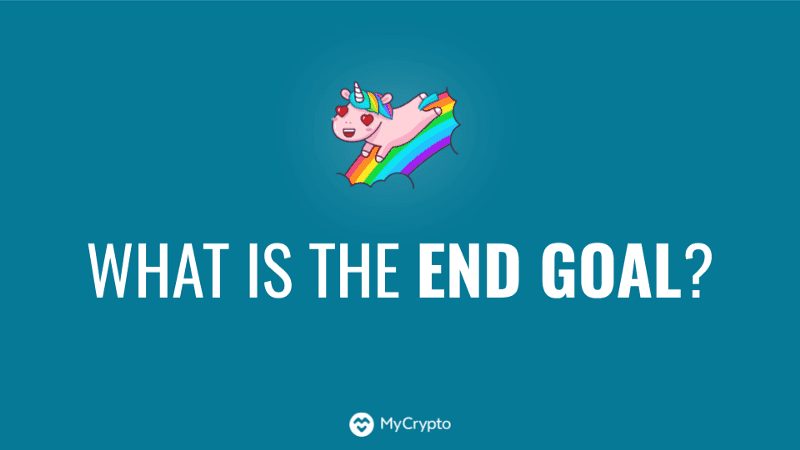
What are we trying to achieve? Why are we here? Why were we first inspired to get into this space? What caused us to dive down the crypto rabbit-hole?
Decentralization is NOT the end goal.
Decentralization is not a value proposition. It’s just… decentralization.
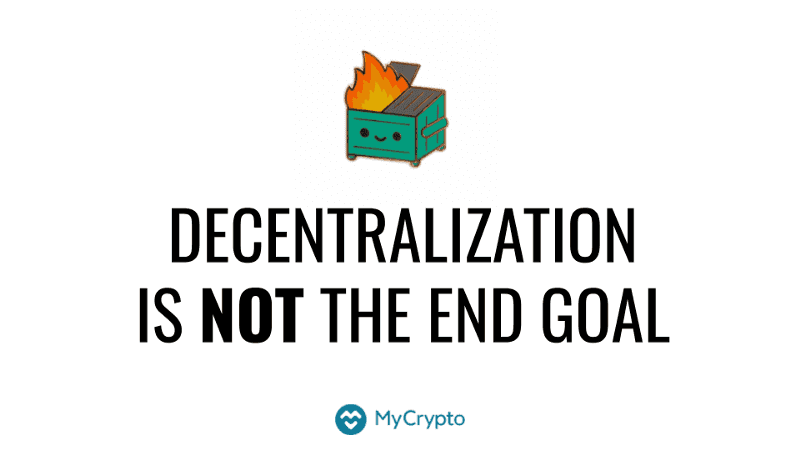
One problem with decentralization is that its meaning varies drastically across different situations and locales. Frankly, the word is one small step from being completely meaningless.
Beyond semantics, though, decentralization is just a nifty feature. It’s the means to an end, but it is not the end. Just because you made something decentralized, doesn’t mean that you made something valuable.
Decentralization is simply a mechanism by which value can be created. It’s a tool we can use to achieve optimal results.
We say that we want decentralization because we understand that it can lead to a future where no single entity has too much power. It can lead to a future where no single entity can abuse us.
But, decentralization, or by distributing the power, is only the how.
And if we focus too heavily on “decentralize!” without focusing on the end goal itself, it will typically result in a system that is neither decentralized, nor usable, nor valuable.
Let’s look at a hypothetical example:

- A team wants their dapp to be able to send a request for payment to a user’s mobile phone wallet, even when a user is accessing their dapp on a regular, old browser.
- The team wants it to be decentralized.
- The team creates a mechanism to connect the dapp with the user’s wallet, wherein the user scans a QR code displayed in the dapp with their mobile wallet.
- The team discovers that this mechanism doesn’t always work, nor does it allow the dapp to push notifications, which significantly hinders the user experience.
- The team implements a central server to improve these UX issues, assuming they’ll figure out a better solution later.
- The team launches the product and touts its decentralization and innovative features.
What’s the problem with that?
This style of building is incredibly common in this space, for understandable reasons. The team was forced to consider a number of trade-offs each time they made a decision: do we choose decentralization, security, usability, or feasibility?
However, at no point does the team stop and re-examine how their choice plays into the whole picture. Instead, they make the best decision for that specific step and move on.
What results is a product that…
- Relies on a central server, meaning the product disappears if the team who created the product disappears.
- Transfer sensitive information like transaction information, mobile phone identifier, IP address, geo-location, whatever, via that central server.
- Requires the user to scan a QR code in order to interact.
If this team had zoomed out, they would have realized that by attempting to be all the things, they were none of the things. They need to prioritize decentralization or prioritize usability up front, and stick with it throughout the process.
For example…
- On the usability front, they could have used a standard login, like oauth2. This would have eliminated the QR codes, ensured a slicker experience overall, and even enabled account recovery without significant additional extra effort on the team’s end.
- On the decentralization front, they could have forgone the push notifications for assurances that the product would still work, even if the entire team was hit by a bus. Users could also rely on the fact that no server could collect their personal information, rather than choosing to trust that it wouldn’t collect their personal information.
Instead, we have neither… and both. ¯\_(ツ)_/¯
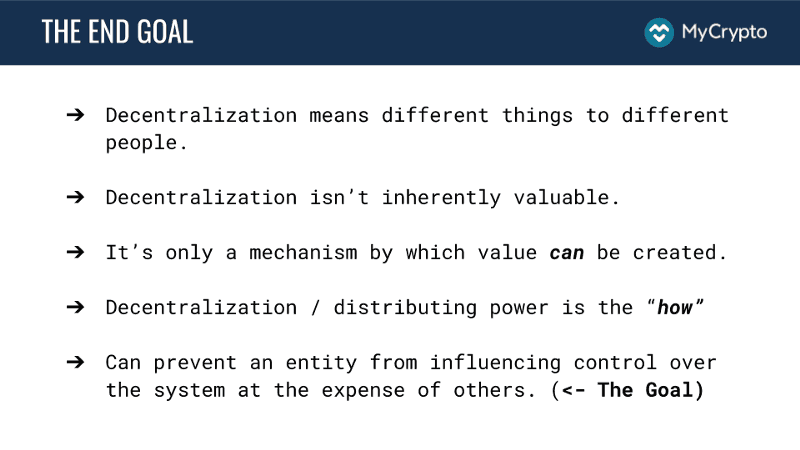
I want to explore a tangible end goal that is applicable to most people in this space. When I think about what I want to achieve, what my goals are, and what success looks like to me, I often think about empowering individuals. So, let’s say that our collective end goal is:
Create products & systems where power naturally accrues to individuals, not single entities.
It’s a big goal, but it’s one that everyone in this space can reach for. It allows individuals or companies to narrow the scope of the goal in order to make it more tangible, achievable, or fitting to their exact situation.
(If you have a better one, tweet me. One size does NOT fit all, and I’d love to hear your take!)
If we reach this goal, it has the potential to…
- empower individuals and groups.
- distribute power more equally than existing systems.
- provide people with choices.
- give people the power to consent — or not consent — to the interactions they have with the system.
- align incentives.
But, just because we have a goal doesn’t mean we will achieve that goal or realize all of the potential benefits in the short term.
Success or Failure?
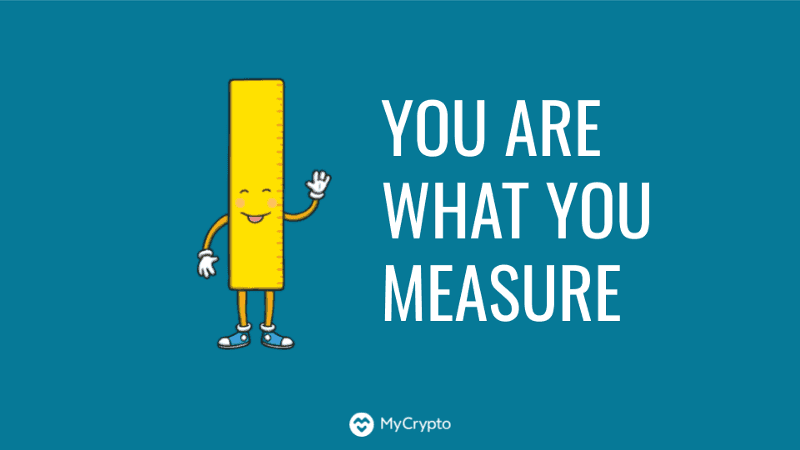
Whenever we talk about what we are trying to achieve, we often do so in the context of “success” and “failure.” However, it helps to know how successful we are. It helps to know if certain actions were more successful than others so we can continue, or discontinue, what we are doing. It’s valuable to be introspective, and metrics are one way we can inspect ourselves, our products, and the people who use our products.
In doing so, remember that “we are what we measure.”
When you are hyper-focused on a specific metric, you will most likely succeed in moving that metric. You will make recruiting decisions, design decisions, technical decisions, and product decisions based on those metrics. However, just because you increased X variable, doesn’t necessarily mean that you are any closer to reaching your end goal. It only means that you increased the variable X.
You may miss important things that the metrics don’t cover that are valuable, or you may adjust your behavior to affect the metrics, forgetting about the underlying goals you previously set. One of the clearest examples of this can be seen when analyzing law enforcement and crime rates. Specifically, there is a stark difference between reducing reported crimes and actually preventing crime.
Research shows, time and time again, that when law enforcement is given directives and rewarded or punished based on metrics (quotas, weekly analysis, bonuses, etc.) they perform. However, the research also shows that, while there is less crime being reported, it doesn’t always correlate to less crime. Cops may choose to not file certain reports or file lesser charges so it appears there is less crime. Cops may choose to arrest someone without enough evidence in order to increase their closure rates.
As we know, incentives are powerful, and we should be mindful of what we are measuring and what we are trying to achieve when it comes to our innovations.

In this space, what are we measuring? What are we focused on most?
- Market cap
- Price
- Daily active users
- TX/sec
- # of addresses
- Mining power
- Volume
- My coin beats your coin
- Network utilization
- TX fees
Unfortunately, none of these things are actually measuring our goals or our success. If we want a system where power accrues to the individual rather than an entity, we need to find ways to measure that.
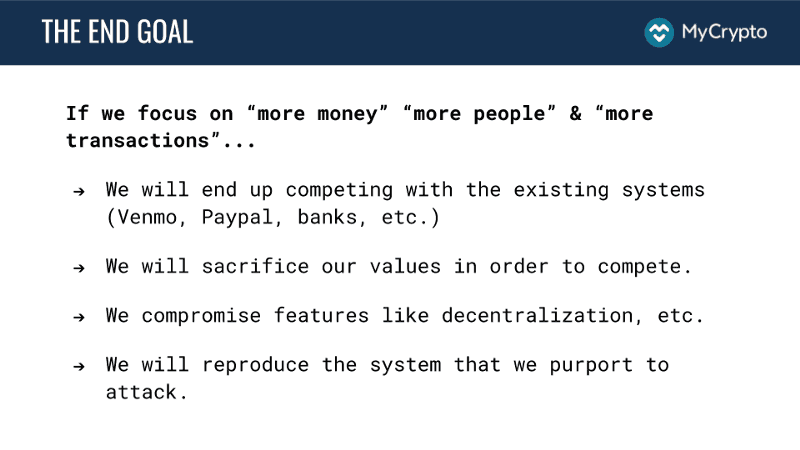
Competing
Additionally, when we are too focused on “more people” and “more transactions” and “more money” we lose sight of what makes us most valuable.
We will end up competing with the existing products in the existing system (Paypal, Venmo, banks, etc.) and, in doing so, we become part of the existing system.
Giving the users a choice between Paypal and Venmo isn’t really giving users a choice. The blockchain is supposed to do something more.
But, because we are competing with these products and we are tracking metrics like users and volume, we will focus on our design, usability, and adoption rates in order to make numbers go up.
Things that we are familiar with (e.g., logging in with a username and password) are simply more usable than things we aren’t used to (e.g., AHH PRIVATE KEYS!). If we identify that as the thing preventing adoption and then solve it by creating a central login system, that would mean we no longer provide a system where a person’s access to their money is not reliant on the existence of a single company.
We have sacrificed decentralization and autonomy and self-sovereignty in order to share fancy user-growth graphs. And because we don’t have a “decentralization” graph, no one will notice the numbers going down on that end.
The fear is that if we all do this enough times, we will end up reproducing the same system that we purport to attack. People still won’t really have a choice, they will just have Paypal, Venmo, and Chainpal. We will have still failed.
Ignoring what makes us better

Our products will not succeed if we don’t utilize the differentiating features the blockchain enables. We need to create new value that isn’t accessible in the existing system. Think less about competing directly and attempting to beat others at their own game and think more about what makes you unique already.
Usability, design, and availability to the middle class or western world are not issues in the existing system. Those have long been solved by a pile of products.
Instead, where is the asymmetry of power? Where is the asymmetry of information? Where are those people who are living without access, without insight, without consent, and without choice?
How can we create products that solve their issues? The real value of what you build is solving people’s problems, not digger a deeper moat than Venmo.
For all the disadvantages new technology has, one benefit is that it inherently grants you a competitive advantage. The fact that blockchain doesn’t rely on a single-point-of-failure is, inherently, more valuable than existing products. Even if our design sucks, we still are better than the existing products in that way. Capitalize on that.
That was Part 2. Stay tuned for Part 3 in the next week or so.
–Taylor 💖
References & Further Reading
- Taylor Monahan @ Devcon 5 // Video version of this article
- Tokenization of Everything
- a16z Podcast: From the Internet’s Past to the Future of Crypto
- https://twitter.com/Melt_Dem/status/1177624330278199297
- For tech giants, a cautionary tale from 19th century railroads on the limits of competition
- Cryptocurrency Might be a Path to Authoritarianism
- LessWrong: What Failure Looks Like
- Attacked from Within
- The Reverse of Stupidity is not Intelligence
- The Four Desires Driving All Human Behavior: Bertrand Russell’s Magnificent Nobel Prize Acceptance Speech